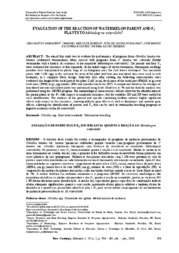Evaluation of the reaction of watermelon parent and F1 plants to Meloidogyne enterolobii.
Evaluation of the reaction of watermelon parent and F1 plants to Meloidogyne enterolobii.
Author(s): DAMACENO, L. S.; QUEIROZ, M. A. de; DIAS, R. de C. S.; CASTRO, J. M. da C. e; TEIXEIRA, F. A.
Summary: The aim of this study was to evaluate the performance of progenies from Citrullus lanatus var. lanatus (cultivated watermelons) when crossed with progenies from C. lanatus var. citroides (fodder watermelon with a historic of resistance to the nematode Meloidogyne enterolobii). The parents and their F1s were evaluated for resistance to this nematode. In the initial stages of eleven treatments, watermelon seedlings plantlets were transplanted to plastic bags of six kilograms once the first leaves developed. Ten inoculated plants with 5,200 eggs in the soil near the stem of the plant and four non-inoculated ones were used in each treatment, in a complete block design. Sixty-two days after sowing, the following characteristics were evaluated: the length of the aerial part of the plant (LAP, in m), fresh mass of the aerial part (FMAP, in g), root fresh mass (RFM, in g), egg number (EN) and reproduction factor (RF). A comparison between the averages of inoculated and non-inoculated plants was performed using Scott-Knott test at 5% and the diallelic analysis was performed using the GENES program. The morphological characteristics did not allow for the identification of the parent plants or the F1s with respect to nematode resistance, but the variables EN and RF were useful for such identification. The analyses of the general and specific combining abilities indicate highly significant effects with respect to this resistance, showing additive gene effects as well as dominance and epistatic gene effects, allowing for identification of parents and F1s that can be used in watermelon breeding programs to improve resistance to the M. enterolobii.
Publication year: 2016
Types of publication: Journal article
Unit: Embrapa Semi-arid Region
Observation
Some of Embrapa's publications are published as ePub files. To read them, use or download one of the following free software options to your computer or mobile device. Android: Google Play Books; IOS: iBooks; Windows and Linux: Calibre.
Access other publications
Access the Agricultural Research Database (BDPA) to consult Embrapa's full library collection and records.
Visit Embrapa Bookstore to purchase books and other publications sold by Embrapa.

